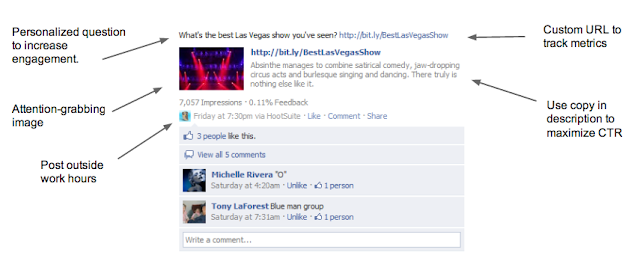Social networks go in and out of style.
Pinterest is all the rage this year. While Facebook stock is at an all-time low.
And there’s a new “must-use” tool that pops up every other week.
Fortunately, none of that really matters.
Because marketing’s not about the tools or technology.
In fact, you don’t even have to stay up with the news or “what’s hot right now”.
There are underlying principles you can use — on any social network — to get more fans, increase engagement and ultimately drive sales.
In fact, you can fit a lot of these principles into a single status update.
See if you can spot them…

How to Uncover the Key to Unlocking Growth and Sales
It’s hard to accurately measure sales from social media.
But it can still give you a wealth of insight about your customers.
You can get demographic data and clues about their interests. But more importantly, you can start to uncover their underlying emotional triggers.
These triggers might get them to “Like” your page. But they’re also the motivations that can get them to buy.
I recently worked on a client’s Facebook page. I analyzed posts with the biggest reach and most engagement, to see if I could identify patterns. Here’s what I found:
- People like personal questions. Most of the popular posts had specific questions like, “Do you think…”, or “How do you feel…”.
- People like discussing and sharing their plans for fun/exciting events like vacations and holidays. People loved sharing their plans for the holidays. It doesn’t matter if they were staying home or going to the Bahamas. These plans touched an emotional nerve (get to see family, spend time with loved ones, get to skip work) and people had strong feelings.
- People like to save money. For us regular folk, this should be a no-brainer. The only exception is if you have a brand/product that caters to the high-end, luxury market.
- People like discussing kids. Again, people enjoy discussing topics they have an emotional connection with. Even if you poke fun teasingly and ask them “how they survive long car rides with their kids”. It still evokes a response, and people like sharing their sarcastic remarks.
- The biggest reach for posts are usually Monday – Thursday, around 7:00pm and between 11:00 – 2:00. Your audience will respond more on certain days of the week, and specific times during the day. You should try to identify these time blocks quickly so you can expose your content to the most fans possible.
Now that’s a start. But you still have to analyze what people don’t like. So try to identify what turned people off or prevented them from responding.
- Self-promotion: People don’t like when you self-promote. Why? Because people only care about themselves. Harsh, but true.
- Hyperbole: Strong words and capitalization like, “YOU CAN’T MISS THIS…” may work once or twice. But it will eventually turn people off. They’ll either ignore you, or just un-friend you.
- Vague Questions: Although people like questions, they don’t like vague ones. So make sure you use concrete questions about specific topics.
Obviously everyone’s results will be a little different. It’s always going to depend on your customers, product/service and industry.
But these examples should help you analyze your own results and show you what to look for. And they’ll show you how to use the following 3 skills to your advantage.
The 3 Underlying Skills You Need to Succeed
1. Psychology: Uncovering what motivates your customers.
Demographic information is a good start. It gives you a general idea of who you’re talking to.
But if you want better results, then you need to go deeper and figure out what makes them take action.

So if people don’t like seeing your “self-promotion updates”, then figure out how you can re-position it.
Find the challenges they face on a daily basis, and pain points they experience, and position your product or service as the “solution” or “cure”.
2. Copywriting: Knowing how to communicate those motivations in the best way.
Once you understand what your customers want, then you need to communicate it effectively.
There are two important parts in the example above.
- The Headline: needs to grab attention and hold their interest. You do that by playing on their triggers (see #1), and other common emotional benefits like simplifying their life or preventing a threat.
- The Description: needs to provide enough information to let them know what it’s about, but still be interesting and mysterious enough that someone wants to click-through and read everything else.
And this is where most companies go wrong. So cut out jargon, complex language and speak as clearly as possible.
Sure, your product or service has to make logical sense for people financially.
But that’s not why they buy from you. They buy from you because they like or trust you.
And because they know that you understand exactly how they feel (and how to help them).
3. Analytical: Test, experiment, measure and iterate.
The hard part of this process is doing the initial research, understanding your customer’s psychology, and then properly communicating it.
Once you’ve done that, it’s easy to get more fans, traffic or sales.
Do more of what they like, and less of what they don’t.
It’s that easy.
Use Facebook Insights to get some initial data. Record the qualitative feedback people give you. Use a Bit.ly link to track click-through-rates.
Try some new things, and see how people respond. Then rinse and repeat.
And you’ll start to better social media results across the board.
Because when you understand the underlying principles and skills, then it doesn’t matter what platform you’re using or which new tool is popular.
You’ll still be able to thrive.


